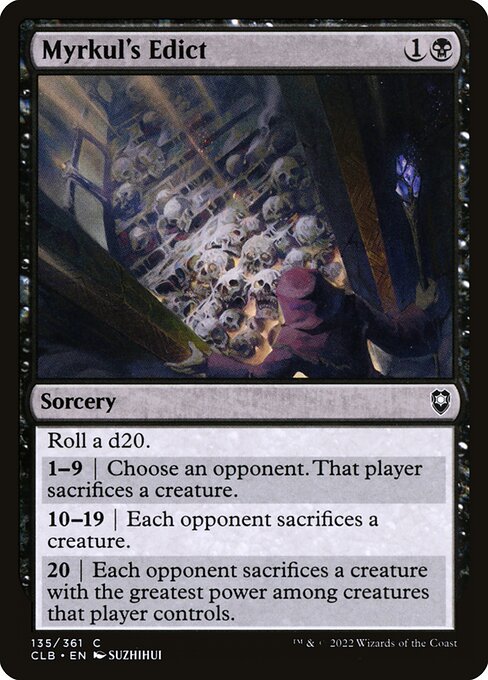
Image courtesy of Scryfall.com
Subtext in its set flavor: deciphering Myrkul's Edict
When you crack open Commander Legends: Battle for Baldur's Gate, you expect a dash of D&D drama and a ring of fate around the battlefield. Myrkul's Edict delivers both with a quiet, surgical bite. For a mere {1}{B} in mana cost, this common spell invites a roll of the d20 that can tilt the entire table—turning luck into leverage and leverage into legend. The flavor of a death-god’s mandate isn’t loud here; it whispers through the die, the consequences, and the way players lean forward in anticipation every time the die skitters across the table. 🧙♂️🔥
In practical terms, the subtext is about control through uncertainty. Black mana has long mined the space between power and price—sacrifice, reanimation, and calculated risk—and Myrkul’s Edict leans into that tradition. The “edict” theme feels twins with the Baldur’s Gate setting: a world where grand feasts of magic mingle with ruthless bargains at a shadowed table. The art direction—bone pale tokens, muted shadows, and a sense of a long oath being spoken—pulls you into a moment where fate isn’t a spectator but an active participant. The flavor pairs with the dice mechanic to suggest that in this realm, even a god’s command must reckon with chance. 🎨⚔️
Flavor as subtext: what the card implies about Myrkul and Baldur's Gate
Myrkul is a name that carries weight beyond the card frame—a nod to the Forgotten Realms’ pantheon of death and dominion. The Edict’s three outcomes map a moral ledger in which deicide terms are not static: a targeted sacrifice, a board-wide sacrifice, or a dramatic, power-focused sacrifice at the highest tier. The subtext is not just about removing threats; it’s about testing the table’s willingness to embrace risk for a chance at momentum. In a world where necromancy and fate intertwine, the Edict becomes a narrative tool as much as a removal spell, inviting players to read the room and weigh the odds as if they were characters in a grand Baldur’s Gate saga. 🧙♂️🎲
Design and mechanics: how the dice shift the battlefield
This two-mana spell is a clean entry point for black's hallmark strategies, but the dice introduce a storytelling layer that makes every casting feel like a chapter in a shared epic. The roll of a d20 yields three distinct arcs of impact:
- 1 through 9: You choose an opponent who sacrifices a creature of their choice. A targeted nudge that can prune a problematic blocker or threaten a key piece in an adversary's plan.
- 10 through 19: Each opponent sacrifices a creature of their choice. A wide-stroke reset that can derail a fragile board state or accelerate your own looming plan, depending on who’s in the hot seat.
- 20: Each opponent sacrifices their creature with the greatest power among those they control. A dramatic, high-stakes payoff that punishes heavy hitters and ramp strategies alike, often reshaping the table’s power balance in a single moment.
That spectrum—targeted pressure, global disruption, and a power-based blow—gives you a surprising amount of control for a relatively cheap spell. It’s a reminder that luck doesn’t erase skill; it amplifies the wheelhouse you’re already playing in. In Commander, where every table has its own rhythms, Myrkul's Edict can be a game-defining pivot or a carefully timed spectacle. 🎲💎
Where it fits in the broader deck-building landscape
As a common in CLB, Myrkul's Edict isn’t about raw power; it’s about flexibility and flavor. It slots neatly into sacrifice-focused builds, aristocrats, or control shells that enjoy weaving risk into response. The black identity pairs naturally with outlets that profit from death triggers, creatures leaving the battlefield, or reanimation synergies, creating a dynamic where the die roll can be the spark that sets off a larger chain of events. In EDH circles, the card shines at a table that appreciates the drama of fate and the dance between table politics and personal strategy. Its place in the broader suite of Commander Legends: Battle for Baldur's Gate highlights Wizards’ ongoing love affair with dice-driven storytelling, a bridge between classic MTG tactics and the tactile, narrative joy of D&D. 🧙♂️🎲
Roll the die; let fate decide the pace. Myrkul's Edict doesn’t just remove threats—it invites you to narrate the moment your table leans into chaos.
Art, lore, and collector’s mood
SUZHIHUI’s artwork for this card threads a gothic elegance through the mechanics. The imagery settles into a quiet, necromantic mood rather than a blow-by-blow attack scene, inviting players to imagine the hush of a room where a death deity speaks in whispers and dice rattle with potential. The set’s cross-pusion of MTG and D&D lore is front and center here, offering a taste of Baldur’s Gate’s political intrigue and mortal fear, all within a single spell. The card’s EDHREC rank—5315—signals a steady, if not explosive, heartbeat in the community of long-form commanders who enjoy a good dice-chase as much as a solid sacrifice engine. 🔥⚔️
Collectibility, price, and how it feels to own a copy
Being a common in a modern-era set, Myrkul's Edict is accessible to most collectors and players alike. The non-foil copy sits in a budget-friendly tier, with foils offering a touch more sparkle for those who chase shiny trinkets. The magic lives in the moment: the die lands on a number, and a decision set in motion changes the room’s dynamics for the next several turns. It’s the kind of card that earns stories at the table, and that is often worth more in memory than in minted value. 🧙♂️💎
For builders who crave a narrative edge, pair Myrkul’s Edict with sacrifice outlets, token generators, and reanimation tricks. The spell’s text doesn’t demand a specific combo; it rewards creative sequencing and table awareness, turning a simple dice roll into a dramatic turning point. This is classic Commander flavor: a moment that lingers, a consequence that echoes, and a dice roll that might become a legend told at future gatherings. 🎲🎨